复旦大学【克鲁格曼《国际经济学》第六版英文课件】CH12
- 格式:ppt
- 大小:748.00 KB
- 文档页数:41
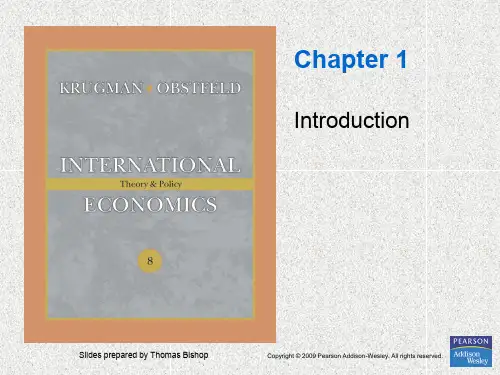
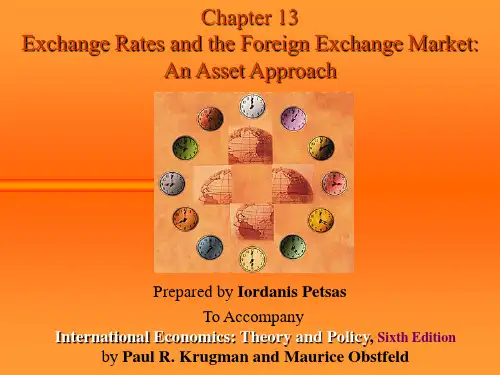
![国际经济学克鲁格曼版[]PPT课件](https://uimg.taocdn.com/90382b676c175f0e7dd1372e.webp)
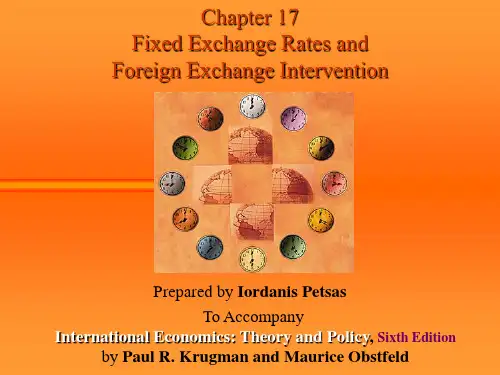
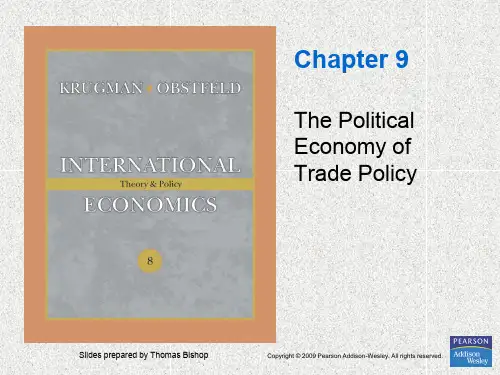
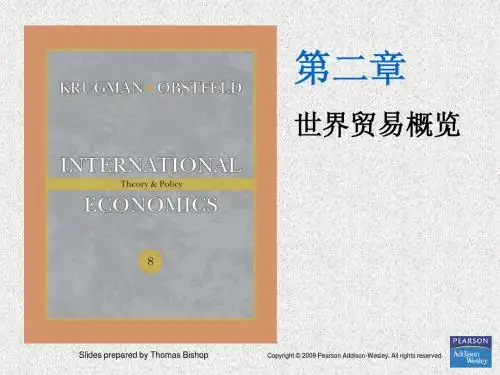
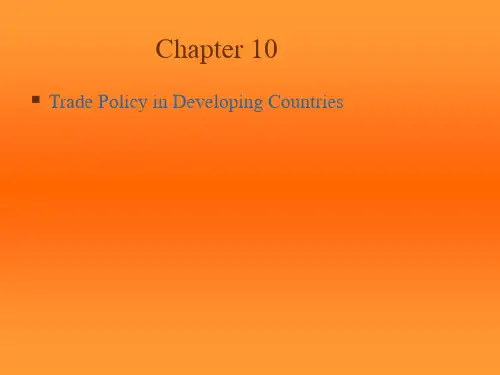
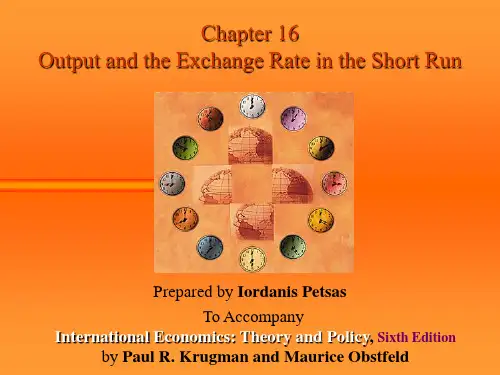
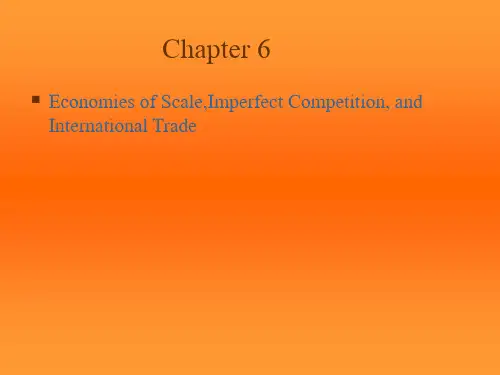
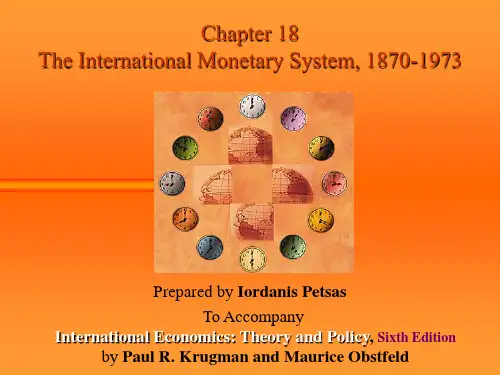
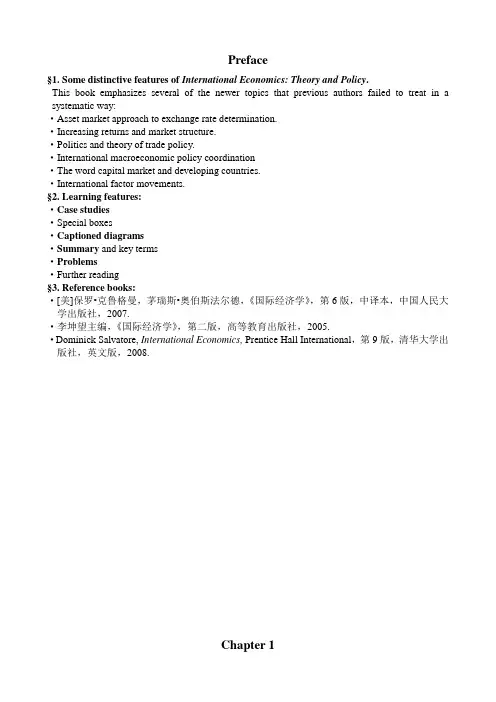
Preface§1. Some distinctive features of International Economics: Theory and Policy.This book emphasizes several of the newer topics that previous authors failed to treat in a systematic way:·Asset market approach to exchange rate determination.·Increasing returns and market structure.·Politics and theory of trade policy.·International macroeconomic policy coordination·The word capital market and developing countries.·International factor movements.§2. Learning features:·Case studies·Special boxes·Captioned diagrams·Summary and key terms·Problems·Further reading§3.Reference books:·[美]保罗•克鲁格曼,茅瑞斯•奥伯斯法尔德,《国际经济学》,第6版,中译本,中国人民大学出版社,2007.·李坤望主编,《国际经济学》,第二版,高等教育出版社,2005.·Dominick Salvatore, International Economics, Prentice Hall International,第9版,清华大学出版社,英文版,2008.Chapter 1Introduction·Nations are more closely linked through trade in goods and services, through flows of money, and through investment than ever before.§1. What is international economics about?Seven themes recur throughout the study of international economics:·The gains from trade(National welfare and income distribution)·The pattern of trade·Protectionism·The balance of payments·Exchange rate determination·International capital market§2. International economics: trade and money·Part I (chapters 2 through 7) :international trade theory·Part II (chapters 8 through 11) : international trade policy ·Part III (chapters 12 through 17) : international monetary theory ·Part IV (chapters 18 through 22) : international monetary policyChapter 2 World Trade: An Overview§1 Who Trades with Whom?1. Size Matters: The Gravity Model•The size of an economy is directly related to the volume of imports and exports.•Larger economies produce more goods and services, so they have more to sell in the export market. Larger economies generate more income from the goods and services sold, so people are able to buy more imports.• 3 of the top 10 trading partners with the US in 2003 were also the 3 largest European economies: Germany, UK and France. These countries have the largest gross domestic product (GDP) in Europe.Cultural affinity: if two countries have cultural ties, it is likely that they also have strong economic ties.Geography: ocean harbors and a lack of mountain barriers make transportation and tradeeasier.2. Distance Matters: The Gravity ModelDistance between markets influences transportation costs and therefore the cost of imports and exports. Distance may also influence personal contact and communication, which may influence trade.Estimates of the effect of distance from the gravity model predict that a 1% increase in the distance between countries is associated with a decrease in the volume of trade of 0.7% to 1%.Borders: crossing borders involves formalities that take time and perhaps monetary costs like tariffs. These implicit and explicit costs reduce trade. The existence of borders may also indicate the existence of different languages or different currencies, either of which may impede trade more.3.The gravity modelThe gravity model is:a b c ij i j ijT A Y Y D =⨯⨯ where a, b, and c are allowed to differ from 1.§2. The Changing Composition of Trade1. Has the World Become “Smaller ”?There were two waves of globalization.1840–1914: economies relied on steam power, railroads, telegraph, telephones. Globalization was interrupted and reversed by wars and depression.1945–present: economies rely on telephones, airplanes, computers, internet, fiber optics,…2. Changing Composition of TradeToday, most of the volume of trade is in manufactured products such as automobiles, computers, clothing and machinery.Services such as shipping, insurance, legal fees and spending by tourists account for 20% of the volume of trade.Mineral products (e.g., petroleum, coal, copper) and agricultural products are a relatively small part of trade.Multinational Corporations and OutsourcingBefore 1945, multinational corporations played a small role world trade.But today about one third of all US exports and 42% of all US imports are sales from one division of a multinational corporation to another.Chapter 3Labor Productivity and Comparative Advantage:The Ricardian Model*Countries engage in international trade for two basic reasons:·Comparative advantage: countries are different in technology (chapter 3) or resource (chapter 4).·Economics of scale (chapter 6).*All motives are at work in the real world but only one motive is present in each trade model.§1. The concept of comparative advantage1. Opportunity cost : The opportunity cost of roses in terms of computers is the number of computers that could have been produced with the resources used to produce a given number of roses.Table 3-1 Hypothetical Changes in Production Million Roses Thousand Computers United States-10 +100 South America+10 -30 Total 0 +702. Comparative advantage : A country has a comparative advantage in producing a good if the opportunity cost of producing that good in terms of other goods is lower in that country than it is in other countries.·Denoted by opportunity cost.·A relative concept : relative labor productivity or relative abundance.3. The pattern of trade: Trade between two countries can benefit both countries if each country exports the goods in which it has a comparative advantage.§2. A one-factor economy1.production possibilities: LC C LW W a Q a Q L +≤Figure 3-1 Home’s Production Possibility Frontier2. Relative price and supply·Labor will move to the sector which pays higher wage.·If C W LC LW P P a a >(C LC W LW P a P a >, wage in the cheese sector is higher ), the economy will specialize in the production of cheese.·In a closed economy, C W LC LW P P a a =.·If each country has absolute advantage in one good respectively, will there exist comparative advantage?§3. Trade in a one-factor world·Model : 2×1×2·Assume: **LC LW LC LW a a a a <Home has a comparative advantage in cheese.Home ’s relative productivity in cheese is higher.Home ’s pretrade relative price of cheese is lower than foreign.·The condition under which home has the comparative advantage involves all four unit labor requirement, not just two.1. Determining the relative price after trade·Relative price is more important than absolute price, when people make decisions on production and consumption.·General equilibrium analysis: RS equals RD . (World general equilibrium)·RS : a “step ” with flat sections linked by a vertical section. **(/)(/)LC LW L a L aFigure 3-3 World Relative Supply and Demand·RD : subsititution effects·Relative price after trade: between the two countries ’ pretrade price.(How will the size of the trading countries affect the relative price after trade? Which country ’s living condition improves more? Is it possible that a country produce both goods?)2. The gains from tradeThe mutual gain can be demonstrated in two alternative ways.·To think of trade as an indirect method of production :(1/)()1/LC C W LW a P P a > or C W LC LW P P a a >·To examine how trade affects each country ’s possibilities of consumption.Figure 3-4 Trade Expands Consumption Possibilities(How will the terms of trade change in the long-term? Are there income distribution effects within countries? )3. A numerical example:·Two crucial points :When two countries specialize in producing the goods in which they have a comparative advantage, both countries gain from trade.Comparative advantage must not be confused with absolute advantage; it is comparative, not absolute, advantage that determines who will and should produce a good.Table 3-2 Unit Labor Requirements Cheese WineHome 1LC a = hour per pound 2LW a = hours per gallonForeign*6LC a = hours per pound *3LW a = hours per gallon absolute advantage; relative price; specialization; the gains from trade.4. Relative wages·It is precisely because the relative wage is between the relative productivities that each country ends up with a cost advantage in one good.***LC LC LW LW a a w w a a >> **LC LC wa w a <;**LW LW wa w a >·Relative wages depend on relative productivity and relative demand on goods.Special box: Do wages reflect productivity?·Debates about relative wages and relative labor productivity.·Long-run convergence in productivity produces long-run convergence in wages.§4. Misconceptions about comparative advantageThe proposition that trade is beneficial is unqualified. That is, there is no requirement that a country be “competitive ” or that the trade be “fair ”.1. Productivity and competitivenessmyth1: Free trade is beneficial only if your country is strong enough to stand up to foreigncompetition.·The gains from trade depend on comparative advantage rather than absolute advantage.·The competitive advantage of an industry depend on relative labor productivity and relative wage. ·Absolute advantage: neither a necessary nor a sufficient condition for comparative advantage (or for the gains from trade).2. The pauper labor argumentmyth2: Foreign competition is unfair and hurts other countries when it is based on low wages. ·Whether the lower cost of foreign export goods is due to high productivity or low wages does not matter. All that matter to home is that it is more efficient to “produce ” those goods indirectly than to produce directly.3. Exploitationmyth3: Trade exploits a country and makes it worse off if its workers receive much lower wagethan workers in other nations.·Whether they and their country are worse off?·What is the alternative ?(If it refuses to trade, real wages would be even lower).§5. Comparative advantage with many goods·Model: 2×1×n·For any good we can calculate *Li Li a a , label the goods so that the lower the number, the lower thisratio. ***1122L L L L LN LN a a a a a a <<<(or ***1122L L L L LN LN a a a a a >>>) 1. Relative wages and specialization·Any good for which **Li Li a a w w >will be produced in home. Relative productivity is higher thanits relative wage,**Li Li wa w a <, goods will always be produced where it is cheapest to make them. ·All the goods to the left of the cut end up being produced in home.Table 3-3 Home and Foreign Unit Labor RequirementsApples1 10 10 Bananas5 40 8 Caviar3 124 Dates6 12 2 Enchiladas12 9 0.75 ·if *3w w =, A 、B 、C will be produced in Home and D 、E in foreign.Is such a pattern of specialization beneficial to both countries?(Hint: Comparing the labor cost of producing a (import) good directly and indirectly).2. Determining the relative wage in the multigood model·*w w: RD of labor equals RS of labor.·The relative derived demand for home labor (*L L) will fall when the ratio of home to foreign wages (*w w) rises, because:(1)The goods produced in home became relative more expensive.(2)Fewer foods will be produced in home and more in foreign.Figure 3-5Determination of relative of wages.RD: derived form relative demand for home and foreign goods.RS: determined by relative size of home and foreign labor force (Labor can’t move between countries).§6. Adding transport costs and nontraded goods·There are three main reasons why specialization in the real international economy is not so extreme:(1) the existence of more than one factor of production(2) protectionism(3) the existence of transport cost.E.g. suppose transport cost is a uniform fraction of production cost, say 100 percents. For goods Cand D in table 2-4:D: Home 6hours < 12hours×1/3×2 foreignC: Home 3hours×2 >12hours×1/3 foreignThus, C and D became nontraded goods.·In practice there is a wide range of transportation costs.In some cases transportation is virtually impossible: services such as haircut and auto repair ;goods with high weight-to-value ratio, like cement.·Nontraded goods: because of absence of strong national cost advantage or because of high transportation cost.·Nations spend a large share of their income on nontraded goods.§7. Empirical evidence on the Ricardian model·Misleading predictions :(1)An extreme degree of specialization;(2)Neglect the effects on income distribution;(3)Neglect differences in resources among countries as a cause of trade;(4)Neglect economics of scale as a cause of trade.·The basic prediction of the Ricardian model has been strongly confirmed by a number of studies over years.(1) Countries tend to export those goods in which their productivity is relative high.(2) Trade depends on comparative not absolute advantage.Figure 3-6productivity and exportsChapter 4Resources and trade: the Heckscher-Ohlin model(Factor endowment theory)*Comparative advantage is influence by the interaction between relative abundance and relative intensity.*Relative abundance: the proportions of different factors of production are available in different countries.If(T/L)H<(T/L)F, Home is labor-abundant and Foreign is land-abundant“per captia”,“relative” , no country is abundant in everything.*Relative intensity: the proportions of different factors of production are used in producing different goods.At any given factor prices, if (T C/L C) < (T F/L F), production of Cloth is labor-intensive and production of Food is land-intensive. A good can’t be both labor-intensive and land-intensive.(Factor-proportions theory)§1. A model of two-factor economy1. Assumption of the modelThe same two factors are used in both sectors: T、L ; Cloth、Food.(1)Alternative input combinations: In each sector, the ratio of land to labor used in production depends on the cost of labor relative to the cost of land, w/r.Figure 4A-2w/r↑T↑L↓T/L↑(T C/L C↑and T F/L F↑)(2) Relative intensityAt any given wage-rental ratio, food production use a higher land-labor ratio, food production is land-intensive and cloth production is labor-intensive.2. Factor price and goods prices(1)One-to-one relationshipBecause cloth production is labor-intensive while food production is land-intensive. The one dollar worth isoquant line of cloth and food are shown as Figure4A-3).The two isoquants CC and FF are tangent to the same unit isocost line.Figure 4 A-3When P C raises, the slope of the unit isocost line w/r rises, that is, there is one-to-one relationship between factor price ratio w/r and the relative price of cloth P C/P F (Figure4A-4). The relationship is illustrated by the curve SS.(Suppose the economy produce both cloth and food).Figure 4 A-4(2)Stolper-Sammelson effectIf the relative price of a good rises, the real income of the factor which intensively used in that good will rise, while the real income of the other factor will fall.P C/P F↑w/r↑T C/L C↑,T F/L F↑W/P C=MPL C↑, W/P F=MPL F↑Figure 4-73. Resources and output(1)Relative price、resources and productionGiven the prices of cloth and food and the supply of land and labor, it is possible to determine how much of each resource the economy devoted to the production of each good; and thus also to determine the econom y’s output of each good.the slope of OcC is Tc/Lc , the slope of O F F is T F /L F• In general, the economy aims to maximizes the value of production:C C F F V P Q P Q =+ or F F C F C Q V P P P Q =-(2)Rybczynski effectIf goods prices remain unchanged, an increase in the supply of land will rise the output of food more than proportion to this increase, while the output of cloth will fall.T↑T F↑L F↑;T C↓L C↓Q F↑Q C↓Rybczynski effect: At unchanged relative goods price, if the supply of a factor of production increases, the output of the good that are intensive in that factor will rise, while the output of the other good will fall.Figure 4-10·The economy could produce more of both cloth and food than before.·A biased expansion of production possibilities.·An economy will tend to be relatively effective at producing goods that are intensive in that factors with which the country is relative well-endowed.§2. Effects of international trade between two-factor economies1. Resources 、relative prices and the pattern of tradeAs always, Home and Foreign are similar along many dimensions, such as relative demand and technology. The only difference between the countries is their resources: Home has a lower ratio of land to labor than Foreign does.·relative abundance relative supply relative prices tradeFigure 4-11·H-O proposition: Countries tend to export goods whose production is intensive in factors with which they are abundantly endowed.·Budget constraint: C C F F C C F F P D P D P Q P Q +=+or ()()F F C F C C D Q P P Q D -=⨯-2. Trade and the distribution of income·According to Stolper-Samuelson effect, a rise in the price of cloth raises the purchasing power of labor in terms of both goods, while a rise in the price of food declines the purchasing power of land in terms of both goods.·Owners of a country’s abundant factors gain from trad e, but owners of a country’s scare factors lose.3. Factor price equalization·Factor price equalization proposition: International trade produces a convergence of relative goods prices. This convergence, in turns, causes the convergence of the relative factor prices. Trade leads to complete equalization of factor prices. (Figure4-11,4-7 or Figure 4A-3)Figure 4A-3one-dollar-worth isoquant lines.goods’ price and technologies are the same, so CC、FF are the same in both countries.w/r are the same in both countries.·In an indirect way the two countries are in effect trading factors of production.(Home exports labor: more labor is embodied in Home’s exports than its imports ;Foreign exports land: more land is embodied in Foreign exports than its imports.)·In the real world factor prices are not equalized (Table4-1). Why?Table 4-1 Comparative international Wage Rates (United States=I00)Hourly compensationCountry of production workers, 2000United States 100 Germany121 Japan111 Spain55 South Korea41 Portugal24 Mexico12 Sri Lanka* 2*1969Source: Bureau of Labor Statistics, Foreign Labor Statistics Home Page. Three assumptions crucial to the prediction of factor price equalization are in reality certainly untrue.(1)Both countries produce both goods.(Trading countries are sufficiently similar in their relative factor endowments)(2)Technologies are the sameTrade actually equalizes the prices of goods in two countries.(3)There are barriers to trade: natural barriers (such as transportation costs) and artificial barriers (such as tariffs, import quotas, and other restrictions).Case study: North-south trade and income inequality·Why has wage inequality in U.S. increased between the late 1970s and the early 2000s?(1)Many observers attribute the change to the growth of world trade and in particular to the growing exports of manufactured goods from NIEs .(2)Most empirical workers believed that trade has been at most a contributing factor to thegrowing inequality and that the main villain is technology.§3. The political economy of trade: a preliminary view1. Income distribution in the short run·specific factor(,)M M M Q Q K L =;(,)F F F Q Q T L =·Trade benefits the factor that is specific to the export sector of each country but hurts the factor to the import-competing sectors, with ambiguous effects on mobile factors.·Does trade make each country better off? Is trade potentially a source of gain to everyone?The fundamental reason why trade potentially benefits a country is that it expands the economy ’s choices. This expansion of choice means that it is always possible to redistribute income in such a way that everyone gains from trade.It is possible in principle for a country ’s government to use taxes and subsidies to redistribute income to give each individual more of both goods.·The distinction between income distribution effects due to immobility and those due to differences in factor intensity.The specific factor model: Sectors; temporaryThe H-O model: Factors; permanent·Resources and trade (factor endowment theory)Short-run analysis: the specific factor modelLong-run analysis: H-O model2. Optimal trade policy.There are two ways to look at trade policy:(1) (Normative analysis) given its objectives, what should the government do? What is theoptimal trade policy?(2) (Positive analysis) what are the governments likely to do in practice?·Economists: to maximize the national welfare, free international trade is the optimal policy. ·Three main reasons why economists do not regard the income distribution effects of trade as a good reason to limit trade (P70).3. Income distribution and trade politics.·An example : an import quota : U.S. sugar (P191).·Problems of collective action (P 219).·Typically, those who lose from trade in any particular product are a much more concentrated, informed, and organized group than those who gain.·The formulation of trade policy: A kind of political process.§4. Empirical evidence on the H-O model1.Tests on U.S data. (Table4-2)Table 4-2 Factor Content of U.S. Exports and Imports for 1962Imports Exports Capital per million dollars $2,132,000 $1,876,000Labor(person-years) per million dollars 119 131Capital-labor ratio (dollars per worker) $17,916 $14,321Average years of education per worker 9.9 10.1Source: Rodert Baldwin, “Determinants of the Commodity Structure of U.S. Trade,”American Economic Review61(March1971), pp.126-145·Leontief paradox: U.S. exports were less capital-intensive than U.S. imports. (Capital-labor ratio) ·U.S. exports were more skilled labor-intensive and technology-intensive than its imports. (Average years of education; scientists and engineering per unit of sales)·A plausible explanation: U.S. may be exporting goods that heavily use skilled labor and innovative entrepreneurship(such as aircraft and computer chips), while importing heavy manufactures that use large amounts of capital (such as automobiles).2.Tests on global data. (Table 4-3)Table 4-3 Testing the Heckscher-Ohlin ModelFactor of Production Predictive Success*Capital 0.52Labor 0.67Professional workers 0.78Managerial workers 0.22Clerical workers 0.59Sales workers 0.67Service workers 0.67Agricultural workers 0.63Production workers 0.70Arable land 0.70Pasture land 0.52Forest 0.70*Fraction of countries for which net exports of factor runs in predicted direction.Source: Harry P.Bowen, Edward E. Leamer, and Leo Sveikauskas,“Multicountry,Multifactor Tests of the Factor Abundance Theory,”American EconomicReview 77 (December 1987), pp.791-809.·If the factor-proportion theory was right, a country would always export factors for which the factor share exceeded the income share, import factors for which it was less.·Two-thirds of the factors were trading in the predicted direction less than 70 percents of the time. This result confirms the Leontief paradox on a broader level: Trade often doesn’t run in the direction that the H-O theory predicts.3. Test on North-South tradeNorth-South trade in manufactures seems to fit the H-O theory much better.4. The case of the missing trade.·A previously overlooked empirical problems: The H-O model can predict not only the direction but the volume of trade.·Factor trade in general turns out to be much smaller than the H-O model predicts.·A large part of the reason for this disparity comes from a false prediction of large-scale trade in labor between rich and poor countries.·This puzzle can be resolved only by dropping the H-O assumptions that technologies are the same across countries. (Table4-5)Table 4-5 Estimated Technological Efficiency, 1983 (United States=1)Bangladesh 0.03Thailand 0.17Hong Kong 0.40Japan 0.70West Germany 0.78Source: Trefler, American Economic Review, (December 1995), p.1037Chapter 5The Standard Trade Model* The differences and common features of the three models developed in previous chapters.·model Merit defect The Ricardian model Technology (trade pattern) income distributionThe Specific factor model income distribution trade patternThe H-O model Resources (trade pattern) technology·(1)different PPF(2)different PPF different RS(3)different RS different P C/P F trade* A more general trade model: the models we have studied may be viewed as special cases.·different PPF?(1)Home’s relative labor productivity of cloth is higher than Foreign’sOr (2)Q C=Q C(K,L C), Q F=Q F(T,L F). Home has more capital while Foreign has more land.Or (3)Home is labor-abundant and cloth is labor-intensive, while …·different Pc/P F?At any given Pc/P F, (Q C/Q F)>(Q C*/Q F*), RS lies to the right of RS*, that is (P C/P F)H<(P C/P F)F。
HAPTER 12NATIONAL INCOME ACCOUNTING AND THE BALANCE OF PAYMENTSChapter OrganizationThe National Income AccountsNational Product and National IncomeCapital Depreciation, International Transfers, and Indirect Business TaxesGross Domestic ProductNational Income Accounting in a Closed EconomyConsumptionInvestmentGovernment PurchasesThe National Income Identity for an Open EconomyAn Imaginary Open EconomyThe Current Account and Foreign IndebtednessSaving and the Current AccountPrivate and Government SavingsCase Study: Government Budget Deficit Reduction May Not Increase the Current Account SurplusThe Balance of Payments AccountsExamples of Paired TransactionsThe Fundamental Balance of Payments IdentityThe Current Account, Once AgainThe Financial AccountThe Capital AccountThe Statistical DiscrepancyOfficial Reserve TransactionsBox: The Mystery of the Missing SurplusCase Study: Is the United States the World's Biggest Debtor?SummaryCHAPTER OVERVIEWThis chapter introduces the international macroeconomics section of the text. The chapter begins with a brief discussion of the focus of international macroeconomics. You may want to contrast the type of topics studied in international trade, such as the determinants of the patterns of trade and the gains from trade, with the issues studied in international finance, which include unemployment, savings, trade imbalances, and money and the price level. You can then "preview" the manner in which the theory taught in this section of the course will enable students to better understand important and timely issues such as the U.S. trade deficit, the experience with international economic coordination, European Economic and Monetary Union, and the financial crises in Asia and other developing countries.The core of this chapter is a presentation of national income accounting theory and balance of payments accounting theory. A solid understanding of these topics proves useful in other parts of this course when students need to understand concepts such as the intertemporal nature of the current account or the way in which net export earnings are required to finance external debt. Students will have had some exposure to closed economy national income accounting theory in previous economics courses. You may want to stress that GNP can be considered the sum of expenditures on final goods and services or, alternatively, the sum of payments to domestic factors of production. You may also want to explain that separating GNP into different types of expenditures allows us to focus on the different determinants of consumption, investment, government spending, and net exports.The relationship between the current account, savings, investment, and the government budget deficit should be emphasized. It may be useful to draw an analogy between the net savings of an individual and the net savings of a country to reinforce the concept of the current account as the net savings of an economy. Extending this analogy, you may compare the net dissavings of many students when they are in college, acquiring human capital, and the net dissavings of a country that runs a current account deficit to build up its capital stock. You may also want to contrast a current account deficit that reflects a lot of investment with a current account deficit that reflects a lot of consumption to make the point that all current account deficits are not the same, nor do they all warrant the same amount of concern. The chapter includes a case study on the current account imbalances of the United States and Japan in the 1980s that allows students to frame a policy debate in the context of the accounting relationships presented in the chapter.Balance of payments accounting will be new to students. The text stresses the double-entry bookkeeping aspect of balance of payments accounting. The 1997 U.S. balance of payments accounts provide a concrete example of these accounts. Large statistical discrepancy between the current and capital accounts are discussed in a box on the apparent global current account deficit. These statistical discrepancies illustrate some real-world difficulties in measuring international payments.Note that the book uses the new current / financial / capital account definitions. The old capital account is now the financial account. The current account is the same except that unilateral asset transfers [debt forgiveness or immigrants moving wealth with them] are now in the new capital account. Credits and debits are marked in the same manner; if money comes into a country, it is a credit. A description of the changes along with revised estimates for 1982-98 can be found in the article by Christopher Bach (see references). These changes were made in conjunction with the IMF’s new standards. A des cription of these new standards can be found in the Survey of Current Business Article listed at the end of the references.The chapter concludes with a discussion of official reserve transactions. You may want to stress that, from the standpoint of financing the current account, these official capital flows play the same role as other capital flows. You may also briefly mention that there are additional macroeconomic implications of central-bank foreign asset transactions. A detailed discussion of these effects will be presented in Chapter 17.ANSWERS TO TEXTBOOK PROBLEMS1. The reason for including only the value of final goods and services in GNP, as stated inthe question, is to avoid the problem of double counting. Double counting will not occur if intermediate imports are subtracted and intermediate exported goods are added to GNP accounts. Consider the sale of U.S. steel to Toyota and to General Motors.The steel sold to General Motors should not be included in GNP since the value of that steel is subsumed in the cars produced in the United States. The value of the steel sold to Toyota will not enter the national income accounts in a more finished state since the value of the Toyota goes towards Japanese GNP. The value of the steel should be subtracted from GNP in Japan since U.S. factors of production receive payment for it.2. Equation 2 can be written as CA = (S p - I) + (T - G). Higher U.S. barriers to importsmay have little or no impact upon private savings, investment, and the budget deficit.If there were no effect on these variables then the current account would not improve with the imposition of tariffs or quotas. It is possible to tell stories in which the effect on the current account goes either way. For example, investment could rise in industries protected by the tariff, worsening the current account. (Indeed, tariffs are sometimes justified by the alleged need to give ailing industries a chance to modernize their plant and equipment.) On the other hand, investment might fall in industries that face a higher cost of imported intermediate goods as a result of the tariff. In general, permanent and temporary tariffs have different effects. The point of the question is thata prediction of the manner in which policies affect the current account requires ageneral-equilibrium, macroeconomic analysis.3. a. The purchase of the German stock is a debit in the U.S. financial account. There is acorresponding credit in the U.S. financial account when the American pays with a check on his Swiss bank account because his claims on Switzerland fall by the amount of the check. This is a case in which an American trades one foreign asset for another.b. Again, there is a U.S. financial account debit as a result of the purchase of a Germanstock by an American. The corresponding credit in this case occurs when the German seller deposits the U.S. check in its German bank and that bank lends the money to a German importer (in which case the credit will be in the U.S. current account) or to an individual or corporation that purchases a U.S. asset (in which case the credit will be in the U.S. financial account). Ultimately, there will be some action taken by the bank which results in a credit in the U.S. balance of payments.c. The foreign exchange intervention by the French government involves the sale of aU.S. asset, the dollars it holds in the United States, and thus represents a debit item in the U.S. financial account. The French citizens who buy the dollars may use them to buy American goods, which would be an American current account credit, or an American asset, which would be an American financial account credit.d. Suppose the company issuing the traveler’s check uses a checking account in France tomake payments. When this company pays the French restaurateur for the meal, its payment represents a debit in the U.S. current account. The company issuing the traveler’s check must sell assets (deplete its checking account in France) to make this payment. This reduction in the French assets owned by that company represents a credit in the American financial account.e. There is no credit or debit in either the financial or the current account since there hasbeen no market transaction.f. There is no recording in the U.S. Balance of Payments of this offshore transaction.4. The purchase of the answering machine is a current account debit for New York, and acurrent account credit for New Jersey. When the New Jersey company deposits the money in its New York bank there is a financial account credit for New York and a corresponding debit for New Jersey. If the transaction is in cash then the corresponding debit for New Jersey and credit for New York also show up in their financial accounts.New Jersey acquires dollar bills (an import of assets from New York, and therefore a debit item in its financial account); New York loses the dollars (an export of dollar bills, and thus a financial account credit). Notice that this last adjustment is analogous to what would occur under a gold standard (see Chapter 19).5. a. Since non-central bank capital inflows fell short of the current-account deficit by $500million, the balance of payments of Pecunia (official settlements balance) was -$500 million. The country as a whole somehow had to finance its $1 billion current-account deficit, so Pecunia's net foreign assets fell by $1 billion.b. By dipping into its foreign reserves, the central bank of Pecunia financed the portion ofthe country's current-account deficit not covered by private financial inflows. Only if foreign central banks had acquired Pecunian assets could the Pecunian central bank have avoided using $500 million in reserves to complete the financing of the current account. Thus, Pecunia's central bank lost $500 million in reserves, which would appear as an official financial inflow (of the same magnitude) in the country's balance of payments accounts.c. If foreign official capital inflows to Pecunia were $600 million, the country had abalance of payments surplus of $100 million. Put another way, the country needed only $1 billion to cover its current-account deficit, but $1.1 billion flowed into the country.The Pecunian central bank must, therefore, have used the extra $100 million in foreign borrowing to increase its reserves. Purchases of Pecunian assets by foreign central banks enter their countries' balance of payments accounts as outflows, which are debit items. The rationale is that the transactions result in foreign payments to the Pecunians who sell the assets.d. Along with non-central bank transactions, the accounts would show an increase inforeign official reserve assets held in Pecunia of $600 million (a financial account credit, or inflow) and an increase Pecunian official reserve assets held abroad of $100billion (a financial account debit, or outflow). Of course, total net financial inflows of $1 billion just cover the current-account deficit.6. A current account deficit or surplus is a situation which may be unsustainable in thelong run. There are instances in which a deficit may be warranted, for example to borrow today to improve productive capacity in order to have a higher national income tomorrow. But for any period of current account deficit there must be a corresponding period in which spending falls short of income (i.e. a current account surplus) in order to pay the debts incurred to foreigners. In the absence of unusual investment opportunities, the best path for an economy may be one in which consumption, relative to income, is smoothed out over time.The reserves of foreign currency held by a country's central bank change with nonzero values of its official settlements balance. Central banks use their foreign currency reserves to influence exchange rates. A depletion of foreign reserves may limit the central bank's ability to influence or peg the exchange rate. For some countries (particularly developing countries), central-bank reserves may be important as a way of allowing the economy to maintain consumption or investment when foreign borrowing is difficult. A high level of reserves may also perform a signaling role by convincing potential foreign lenders that the country is credit-worthy. The balance of payments of a reserve-currency center (such as the United States under the Bretton Woods system) raises special issues best postponed until Chapter 18.7. The official settlements balance, also called the balance of payments, shows the netchange in international reserves held by U.S. government agencies, such as the Federal Reserve and the Treasury, relative to the change in dollar reserves held by foreign government agencies. This account provides a partial picture of the extent of intervention in the foreign exchange market. For example, suppose the Bundesbank purchases dollars and deposits them in its Eurodollar account in a London bank.Although this transaction is a form of intervention, it would not appear in the official settlements balance of the United States. Instead, when the London bank credits this deposit in its account in the United States, this transaction will appear as a private financial flow.8. A country could have a current account deficit and a balance of payments surplus atthe same time if the financial and capital account surpluses exceeded the current account deficit. Recall that the balance of payments surplus equals the current accountsurplus plus the financial account surplus plus the capital account surplus. If, for example, there is a current account deficit of $100 million, but there are large capital inflows and the capital account surplus is $102 million, then there will be a $2 million balance of payments surplus.This problem can be used as an introduction to intervention (or lack thereof) in the foreign exchange market, a topic taken up in more detail in Chapter 17. The government of the United States did not intervene in any appreciable manner in the foreign exchange markets in the first half of the 1980s. The “textbook” consequence of this is a balance of payments of zero, while the actual figures showed a slight balance of payments surplus between 1982 and 1985. These years were also marked by large current account deficits. Thus, the financial inflows into the United States between 1982 and 1985 exceeded the current account deficits in those years.FURTHER READINGSChristopher Bach, “U.S. International Transactions, Revised Estimates for 1982-98,” Survey of Current Business, 79 (July 1999):60-74.Peter Hooper and J. David Richardson, eds. International Economic Transactions. Chicago: University of Chicago Press, 1991.David H. Howard. "Implications of the U.S. Current Account Deficit." Journal of Economic Perspectives 3 (Fall 1989), pp. 153-165.International Monetary Fund. Final Report of the Working Party on the Statistical Discrepancy in World Current Account Balances. Washington, D.C.: International Monetary Fund, September 1987.Robert E. Lipsey. "Changing Patterns of International Investment in and by the United States." in Martin S. Feldstein, ed., The United States in the World Economy. Chicago: University of Chicago Press, 1988, pp. 475-545.Rita M. Maldonado. "Recording and Classifying Transactions in the Balance of Payments." International Journal of Accounting 15 (fall 1979), pp. 105-133.James E. Meade. The Balance of Payments. Ch.s 1-3. London: Oxford University Press. 1952.Lois Stekler. "Adequacy of International Transactions and Position Data for Policy Coordination." in William H. Branson, Jacob Frenkel, and Morris Goldstein, eds. International Policy Coordination and Exchange Rate Fluctuations. Chicago: University of Chicago Press. 1990.Robert M. Stern, Charles F. Schwartz, Robert Triffin, Edward M. Bernstein and Walter Lederer. The Presentation of the Balance of Payments: A Symposium. Princeton Essays in International Finance 123. International Finance Section, Department of Economics, Princeton University, August 1977.United States Bureau of the Budget, Review Committee for Balance of Payments Statistics. The Balance of Payments Statistics of the United States: A Review and Appraisal. Washington, D.C.: Government Printing Office, 1965.“The International Monetary Fund’s New Standards for Economic Statistics,” Survey of Current Business, 76 (October 1996):37-47.。